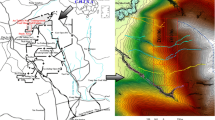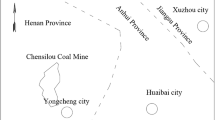Abstract
Shallow seam mining is very common in China for enhancing coal recovery. However, this may cause a series of severe problems in environment and mining safety in some cases, because the alluvium aquifers are directly above the shallow coal seams. Some typical water and sand inrush incidents resulting from shallow mining in China are analyzed. Based on in-situ observation, the mining-induced strata failures are investigated. The height of the fractured zone decreases as the size of the outcrop pillar or mining depth decreases. The spatial distributions of the failure zones in the shallow mining have specific features compared to the deep mining. These provide an advantageous condition for the shallow mining under alluvial aquifers. Optimal designs for outcrop pillar sizes are also given in different hydrogeological conditions for environment friendly and production-safe mining at shallow depths. According to in-situ mining experiments in several coalfields, technical measures for shallow mining are presented. These primarily include the lift mining for thick seams and reduction of the thickness of extraction in the first lift, short-wall mining, and detection of faults and other potential hazards prior to mining.












Similar content being viewed by others
References
Bai M, Elsworth D (1990) Some aspects of mining under aquifers in China. Miner Sci Tech 10:81–91
Booth CJ, Bertsch LP (1999) Groundwater geochemistry in shallow aquifers above longwall mines in Illinois, USA. Hydrogeol J 7(6):561–575
Booth CJ, Spande ED, Pattee CT, Miller JD, Bertsch LP (1998) Positive and negative impacts of longwall mine subsidence on a sandstone aquifer. Environ Geol 34(2/3):223–233
Hasenfus GJ, Johnson KL, Su DHW (1990) A hydromechanical study of overburn aquifer response to longwall mining. In: Peng SS (ed) Proceedings of the 7th international conference on ground control in mining, pp 149–162
Liu T (1981) Coal mine ground movement and strata failure (in Chinese). Coal Industry Press, Beijing
Liu T (1998) Theory and techniques for optimal design of outcrop coal pillar (in Chinese). Coal Industry Press, Beijing
Liu J, Elsworth D (1997) Three-dimensional effects of hydraulic conductivity enhancement and desaturation around mined panels. Int J Rock Mech Miner Sci 34(8):1139–1152
Zhang J (2005) Investigations of water inrushes from aquifers under coal seams. Int J Rock Mech Miner Sci 42(3)
Zhang J, Shen B (2004) Coal mining under aquifers in China: a case study. Int J Rock Mech Miner Sci 41(4):629–639
Zhang J, Zhang Y, Liu T (1997) Rock mass permeability and coal mine water inrush (in Chinese). Geological Publishing House, Beijing
Zhou WF (1997) The formation of sinkholes in karst mining areas in China and some methods of prevention. Environ Geol 31(1/2):50–58
Zipper C, Balfour W, Roth R, Randolph J (1997) Domestic water supply impacts by underground coal mining in Virginia, USA. Environ Geol 29(1/2):84–93
Acknowledgements
First, the authors express their sincere gratitude to Prof. T. Liu for his advice, encouragement, and suggestions during the research of this project. Then the authors thank the following coal mines for their support and permission of data access during the in-situ experiments and investigations, i.e., mines of Daliuta, Dongpang, Longdong, Lujiatuo, Shuangyang, Xingtai, Xuzhuang, Xinglongzhuang, Yangzhuang, Zhuxianzhuang, etc. This research is partially supported by the NSF of China under grants of 50221402 and 50025413 and by China National Program (grant# 2002CB211707) on Key Basic Research Project, and these are gratefully acknowledged.
Author information
Authors and Affiliations
Corresponding author
Rights and permissions
About this article
Cite this article
Zhang, J., Peng, S. Water inrush and environmental impact of shallow seam mining. Environ Geol 48, 1068–1076 (2005). https://doi.org/10.1007/s00254-005-0045-8
Received:
Accepted:
Published:
Issue Date:
DOI: https://doi.org/10.1007/s00254-005-0045-8




